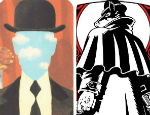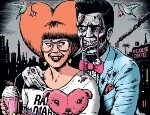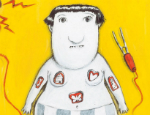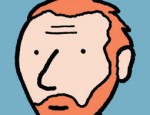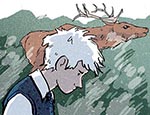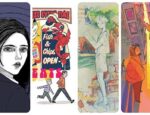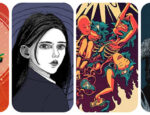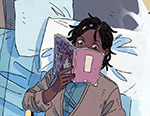Remembering childhood is not unlike remembering a dream, or a story you heard a long time ago, for Rachael Ball it’s all three at once:
“When things are mixed up an excitement is created. You feel a flutter and a spark in your heart. You want to jump out of your seat and you want to write it down quickly! I love that feeling and it often comes from a collision of characters and concepts.”
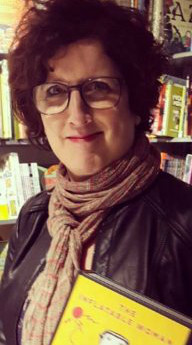 Wolf is a story of images and ideas colliding, in the very real and grounded (albeit nostalgic) setting of a 1970s suburban childhood shot through with grief. Hugo and his family lose their father in the first few chapters of the book, and then proceed to barely mention him for most of the rest of it, as happens. But his presence and absence is felt in a thousand tiny ways.
Wolf is a story of images and ideas colliding, in the very real and grounded (albeit nostalgic) setting of a 1970s suburban childhood shot through with grief. Hugo and his family lose their father in the first few chapters of the book, and then proceed to barely mention him for most of the rest of it, as happens. But his presence and absence is felt in a thousand tiny ways.
When the children decide to build a time machine in their back yard, with the help of a few new local friends, Hugo is clear as clear that it will be used to bring his father back, and that he cannot speak of this. The spectre of their mysterious and infamous next door neighbour, the Wolf Man, develops an irresistible narrative pull once the children realise that the missing parts they need for their go-cart, I mean time machine, are sitting rusting in his garden. But things can still get a whole lot stranger.
Each softly pencilled panel of Ball’s story is like a little world of its own, and each character feels real and brittle and bright like a true dream, or the comments you make around the edges of the fairy-tale when you’re reading it to a small child. Songs and movies and myths and reality rub shoulders and overlap into each other throughout the book and animals and toys are no less charismatic and unfathomable than their human counterparts.
Like most good art Wolf was a lifetime in the brewing; through animating shadows, bittersweet memories, flirting with influences from absolutely all over the place, embracing that heady mix of fine art, pure storytelling and cartooning. Rachael answered some questions from BF’s Jenny Robins that give us some real insight into her processes and history. Enjoy.
BROKEN FRONTIER: Can you tell us a bit about what the book is about and how it originated?
RACHAEL BALL: Wolf is a bit of an amalgam of two stories I always wanted to do. For about 8 years I was working on a picture book for kids called The Wolf Who Lost His Hat. I could never quite get it to work. I even roped my poor cousin, Lee in to co-write it with me but I still wasn’t happy with it. Part of the problem was that I’d done about ten of the paintings before writing it (I read an interview with the children’s author Anthony Browne who said that was his process.)
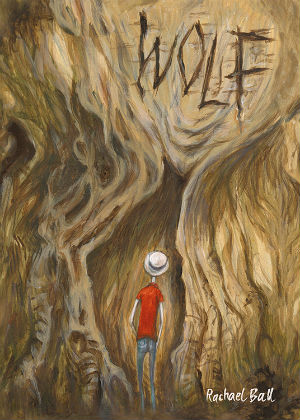 This approach, for me anyhow, turned out to be like building a house with no plan. The fact the kids had no character was quite possibly the second problem. After 8 years working on it each Saturday (!!) I shelved it to work on The Inflatable Woman which was a breath of fresh air after all that! I started thinking about a next project whilst in the last few chapters of TIW. I had several possibilities but I had always wanted to do something about losing my Dad when I was 6.
This approach, for me anyhow, turned out to be like building a house with no plan. The fact the kids had no character was quite possibly the second problem. After 8 years working on it each Saturday (!!) I shelved it to work on The Inflatable Woman which was a breath of fresh air after all that! I started thinking about a next project whilst in the last few chapters of TIW. I had several possibilities but I had always wanted to do something about losing my Dad when I was 6.
Losing Dad had a massive impact on me as an adult and the loss still finds its way to the surface in odd moments. I think when you lose a parent as a child you bury it and when you grieve for them again as an adult… it’s the child grieving that comes out again not the adult. I have found myself refer to my Dad as Daddy at times in conversations. The child’s voice finds her way out.
Part of the problem I found on doing a book about my Dad is I have very few memories of him. Just very vague shadowy ones. Kids often grieve in an invisible way as well. They are so focused on the here and now and emotions run through them fast like a fast, heavy shower. And then they are playing or hungry or something else. This gives the illusion that kids don’t experience grief as hard as adults do. They do, it’s just different. That misrepresentation of children and grief was one of the major motivations to writing the story as well.
However I felt my memory of that time was too unreliable to do a good account of my experience. The alternative was to do a story about the effect on me as a woman growing up without a Dad but that seemed to be another story altogether.
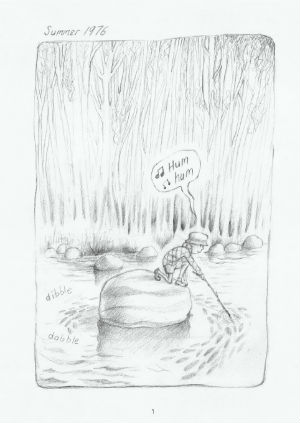 So… as you can see there was a lot of umming and angsting going on in the planning stages! In the end I decided to base the story around another child. A boy… so none of my femininity, insecurities or sexual identity could leak in. I just wanted to really focus on this family and how they dealt on a day-to-day basis with grief and the shock. And a lot of that is by silence. There’s not a lot of talking about the lost person. Kids don’t want to hurt their Mum with memories. So the dead parent becomes the elephant in the room. And the emotional devastation gets pushed down, out of sight.
So… as you can see there was a lot of umming and angsting going on in the planning stages! In the end I decided to base the story around another child. A boy… so none of my femininity, insecurities or sexual identity could leak in. I just wanted to really focus on this family and how they dealt on a day-to-day basis with grief and the shock. And a lot of that is by silence. There’s not a lot of talking about the lost person. Kids don’t want to hurt their Mum with memories. So the dead parent becomes the elephant in the room. And the emotional devastation gets pushed down, out of sight.
So it occurred to me that taking some of the mythical motifs of a fairy story such as the forests, a lost child, and a mysterious and terrible wolf, a loved one snatched away into the Underworlds would convey grief better than reality. The mythical motifs become the emotions unfettered, coming out of the cracks. So I combined the ideas of the fairy tale Wolf who lost his Hat, who in the original kid’s version is magical and scary and I made him into a magical, scary man capable of perhaps doing the unthinkable and helping Hugo rescue his Dad, every bereaved child’s dream
BF: There is a real wolf in the story, but the Wolf-Man character is more prominent and indeed, magical and scary. Did the project start out being called Wolf Man? What informed the decision to shorten it?
BALL: Actually that was a very practical decision. SelfMadeHero had already published the graphic novel The Wolf Man by Richard Appignanesi and Sława Harasymowicz. Publisher Emma (Hayley), asked me very nicely if I would mind changing the name. I’ve adapted… it wasn’t too painful.
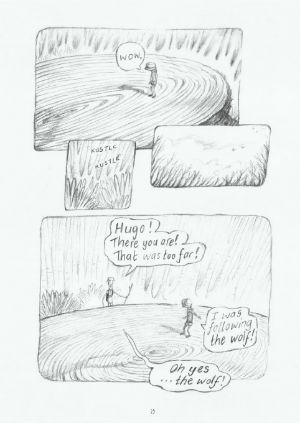 BF: You are very wise and whimsical in your combination of very raw emotions and a sort of light-hearted magical realism, is this how you’ve always dealt with the big stuff in your own wise heart? Or has it evolved this way only in retrospect and recent years?
BF: You are very wise and whimsical in your combination of very raw emotions and a sort of light-hearted magical realism, is this how you’ve always dealt with the big stuff in your own wise heart? Or has it evolved this way only in retrospect and recent years?
BALL: Well first of all thank you for that very magnanimous compliment Jenny! I’m very touched that you said that. Your personality traits get rubbed onto you by all sorts of people and experiences don’t they?
My Mum was a lovely mixture of stoicism and positivity. She was very warm, kind and an extremely good-humoured person and that definitely had an impact on me. It was hard not to see humour in most things after having a mother like mine! She also had a very deep sense of self-confidence and faith in her own brilliance! I love that combination in people – kindness, arrogance, brilliance; all manner of things all mixed together. It’s what makes human beings so great! But my Mum’s humour definitely became something I picked up on and I do find it’s how I deal with difficulties in life.
Growing up by the sea in Blackpool had a massive impact on me as well. I spent a lot of time walking in storms on the beach, getting beaten up by the winds. I reckon all that landscape got swept up and mixed up in all my teenage emotions then slipped off my pencil all those years later.
Losing Dad was massive obviously too. It’s taken me quite a long time to realise that I have been carrying a lot of sadness all my life from losing him and that makes for, as you say, quite raw emotions spilling around under the surface.
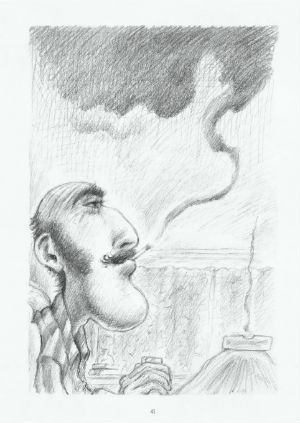 My work evolved and matured a lot through absenting myself from comics. I kind of fell into cartooning at 23 when I entered a competition with Manchester listing magazine, City Life. They were looking for a regular cartoonist. A year later I sent my strips to Deadline and then ended up working for them for 4 years. I was very lucky but I hadn’t actually passionately wanted to be a cartoonist at the time. I don’t know why I hadn’t. I’d been a passionate comics reader as a kid. I wrote illustrated stories in my spare time at Art College. I don’t want to sound like I was a lazy cartoonist! I loved what I did but I presumed that I’d end up doing something else. I didn’t realise I’d actually found what I was meant to do in my 20s. Trouble with youth that, innit?!!
My work evolved and matured a lot through absenting myself from comics. I kind of fell into cartooning at 23 when I entered a competition with Manchester listing magazine, City Life. They were looking for a regular cartoonist. A year later I sent my strips to Deadline and then ended up working for them for 4 years. I was very lucky but I hadn’t actually passionately wanted to be a cartoonist at the time. I don’t know why I hadn’t. I’d been a passionate comics reader as a kid. I wrote illustrated stories in my spare time at Art College. I don’t want to sound like I was a lazy cartoonist! I loved what I did but I presumed that I’d end up doing something else. I didn’t realise I’d actually found what I was meant to do in my 20s. Trouble with youth that, innit?!!
The style and subject of the cartoon work I did then had some similarity to what I do now but I tended to separate the styles. I did dreamy, gothic stuff in the illustrations and some strips. I did a silent strip called The Melon Thief that was very dark and moody and won Italy’s Humorfest comp in 1990 and at the same time I was doing strips about bitchy girls and relationships with quite comical and caricatured characters, Years later the two styles became fused together and at last the styles became happy to be together!!
But it took leaving comics to look after my daughter and then teach for quite a number of years for an artistic frustration at not having time to do my own A/W to build up. And that actually helped my work mature I think and led to me realising how passionate I was about comic stories and visual narratives.
I think that time teaching was also a massive education to me. As an art teacher (and you’ll know this Jenny), you quickly have to learn so many artistic skills and as my daughter was young I didn’t have time to do my own work so I think I was practicing my personal skills in my head and imagining what I’d paint or draw.
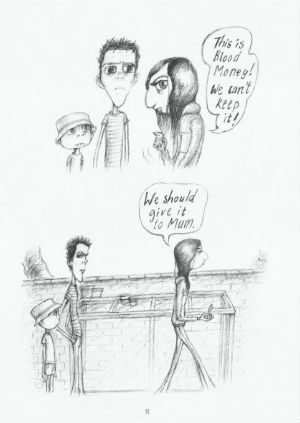 When I eventually had time again it was a fantastic feeling. Art work just came spilling out. Such a bloody relief!! The actual story writing was different. Weirdly it was having cancer that seemed to wake a storyteller up in me.
When I eventually had time again it was a fantastic feeling. Art work just came spilling out. Such a bloody relief!! The actual story writing was different. Weirdly it was having cancer that seemed to wake a storyteller up in me.
Around the time I was diagnosed I was writing to a guy through internet dating (he was the inspiration for Sailorbuoy in The Inflatable Woman), and we would write to each other every day or so. Just silly stuff. Funny and imaginative, very fantasy based and looking back that was very good creative writing practice!!
I wrote the first story that I’m proud of after my mastectomy… a story called Shadows. I had a chapter published as a cartoon strip in The Strumpet. I started to think about it when I was in hospital recovering from surgery. This story came to me about a witch called Ida and it kind of flowed out over the next few months. Funny that. Maybe there is a connection between trauma and creativity. But also having the time and space to think is good when you’ve had so little… Even if it is under such unpleasant circumstances. That time to think/create is a rare commodity for too many people.
It took a while however for me to realise I’d become a cartoonist again. I think I was seeing myself as a visual artist even after doing The Inflatable Woman. I remember reading an article with graphic novelist Karrie Fransman and she was referring to cartoonists as storytellers and I thought “Oh, is that what I am?”
So hmm I guess I am.
BF: The way you talk about these overlapping experiences and influences convinces me even more of your wisdom, and we are lucky that you were able to land on the graphic novel medium as an outlet for that wisdom. The story also has a lot of clear influences and references from stories of different kinds, supernatural and science fictional. Time machine traditions and magical lupine characters seem to come from somewhat opposite genres, how did this mash up come about? Is it all centred in childhood imagination?
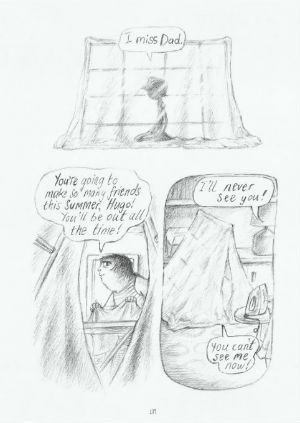 BALL: Hmm I’m not sure they are so different. A lot of fantasy characters are archetypes that take on different forms.
BALL: Hmm I’m not sure they are so different. A lot of fantasy characters are archetypes that take on different forms.
Wanting to move back in time by some means to see your loved ones again; meeting a wolf in a forest, Death on a train or being threatened by a thumb-sized nurse. I think they all come from the same… stable.
And as children we wouldn’t have minded or tried to divide them into compartments.
When things are mixed up an excitement is created. You feel a flutter and a spark in your heart. You want to jump out of your seat and you want to write it down quickly! I love that feeling and it often comes from a collision of characters and concepts.
That permission to creates something illogical (magical realism stuff), for me emerged when I was at college. I was very inspired by authors like Gabriel Garcia Marquez or Ray Bradbury and choreographers like Pina Bausch.
BF: Do you have a personal history with wolves and/or time machines?
BALL: No, I do remember us all watching the original film of The Time Machine though. Brilliant! I was horrified by the Morlocks. I think I had nightmares over them. Actually it suddenly occurs to me that the Morlocks remind me of Goya’s painting of Saturn eating a man. I think it’s supposed to be a child he’s eating. But that’s one of my earliest memories is looking at a book with that painting in. So maybe a personal history with monsters!
I was fascinated by time travel or more place shifting like in C.S. Lewis’s books where the characters go through the wardrobe into Narnia. There’s something about that thought that is hard to resist. Perhaps because we are shifting times and places all the time over the decades and our memories taunt us with the places, times we remember clearly but can’t go back to.
Or just because it would be great to jump around in time. Ha ha ha need to start fantasising about the future places I would go to!!
BF: That would be great! Maybe a future, ‘future’ project!
The literal visual pencil tones of your two opuses are similar, but the narrative tone is quite different, perhaps primarily because of the differing age and gender of the protagonists. Do you see Wolf as taking place in the same universe as the The Inflatable Woman?
BALL: I don’t think so.
The Wolf characters are slightly more realistic and I spent more time paying attention to detail in interiors and exteriors in Wolf. That was important that the story might tap into peoples’ real memories of youth or the 70s.
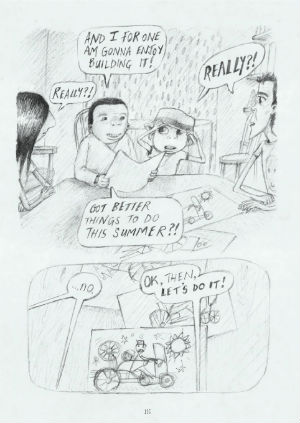 The Inflatable Woman was intentionally a little more clownish. I wanted a juxtaposition between the trauma and bloody weirdness of the hospital experience and the humour of comedic characters in order to enhance the Alice in Wonderland effect of illness and hospitals. When you are going through treatments for something quite serious you are on constant alert for the next bad news and are frequently surprised by the next treatment or unexpected bodily reaction to a treatment so it really is like falling down a rabbit hole and the unexpected is on every turn. Plus hospitals can be well funny places too!
The Inflatable Woman was intentionally a little more clownish. I wanted a juxtaposition between the trauma and bloody weirdness of the hospital experience and the humour of comedic characters in order to enhance the Alice in Wonderland effect of illness and hospitals. When you are going through treatments for something quite serious you are on constant alert for the next bad news and are frequently surprised by the next treatment or unexpected bodily reaction to a treatment so it really is like falling down a rabbit hole and the unexpected is on every turn. Plus hospitals can be well funny places too!
So I needed the comical next to the dark there to express that!
BF: What is your process for building your beautiful pencil artwork? Are you allowed to use a rubber?
BALL: Ah I like the ‘Are you allowed to use a rubber’ question Jenny, that’s such an Art lesson question!
I do allow myself the use of a rubber! A LOT!!! I spend a lot of time redrawing until I get the character’s body and facial expression right, I’ll redraw a panel 5 or 6 times until it’s right. So you can still see my workings out on the page quite often. But I like that. If it’s good enough for Daumier, it’s certainly good enough for me!
I love the economy of pencil and the atmosphere of shading and tonal gradation. I’ve always had a love of that smoky effect in soft tonal painting or pencil work. It’s very sensual and serene. You can feel yourself slipping and falling into the shadows. Love it!
My shading technique got honed a bit working in animation studios. I used to render (or animate shadows), on films like Father Christmas and a Beatrix Potter one too (I can’t remember its name now) but you had to shade the cells (old school animation), so there were no shading marks and pick dots off with a scalpel. I got good at it but I was slooooow!
I think it would be good to close with the disclosure that I was hired to work on Teenage Mutant Ninja Turtles in Dublin when I was about 26. I lasted 3 weeks and got sacked. I’d never animated before. My friend said “It’s easy! Just tell them you’ve done it before¬” I hadn’t and it wasn’t but I fell over Seamus Heaney in a pub in Black Rock and that made up for it.
Thank you Jenny. It’s been a pleasure and a privilege and you do ask such wonderful questions!!!
BF: No no thank YOU Rachael! It’s a relief to know you’re allowed to use a rubber, and I’d love to see you do a sensual and serene Teenage Mutant Ninja/Hero Turtles painting some time! In the meantime, everyone should be checking out Wolf.
If you want to read more about Wolf and read a preview chapter check out Rachael’s Wolf blog here.
She’s also teaching ‘Graphic Novel Your Life’ workshops at the House of Illustration so if anyone needs help if you want help fine tuning, troubleshooting or kick starting their inspiration muscle again sign up for a course.
Wolf is published by SelfMadeHero priced £15.99





